
One small step for man, one giant leap for mousekind.
Scientists have painstakingly mapped the connections in a tiny segment of the mouse's brain. The stunningly intricate picture provides an unprecedented level of detail of an organ smaller than a pebble and lighter than the average cotton ball.
"At the end of the day, we want to understand the human brain. Understanding the mouse brain is an important step toward that goal," Lydia Ng, senior director of technology at the nonprofit Allen Institute for Brain Science in Seattle, told Live Science in an email.
The resulting 3D structure, called the Mouse Common Coordinate Framework, is the equivalent of leveling up from simple paper maps to a Google Maps or GPS for the mouse brain, Ng said.
"Maps of the brain have always been created in two dimensions, but even a stack of flat maps sitting on top of each other does not necessarily align with the complex three-dimensional nature of the brain," neuroscientist Christof Koch, the president and chief scientific officer of the Allen Institute for Brain Science, said in a statement. [See Images of the Mouse Brain Up Close]
Detailed picture
The new map, however, doesn't just track the firing between different brain cells; it also allows researchers to visualize how different genes are expressed in teensy portions of the brain as well as the physical connections between anatomical structures in the brain.
To create this detailed map, researchers carefully measured and examined 1,675 mouse brains and then created a 3D image of an "average mouse brain." From there, the scientists used fluorescently labeled brain cells from the mouse brain as clues to help draw the boundaries between different brain regions. Ultra-high-resolution images of individual brain cells were then translated into digital images.
Get the world’s most fascinating discoveries delivered straight to your inbox.
The ultimate goal for this project, as well as for the the National Institutes of Health's larger BRAIN Initiative, which helped fund the current project, is to create a detailed map of all the connections in the human brain. Though the mouse brain is an important first step, there are many more to go. The human brain weighs about 3.3 pounds (1.5 kilograms), whereas the mouse brain weighs just 0.02 ounces (0.5 grams) — or about the weight of a paper clip. What's more, the mouse brain contains just 70 million neurons, whereas the human brain contains a whopping 86 billion neurons, according to a study published in 2012 in the journal Nature.
Any researcher interested in using the framework or looking at the data can do so at brain-map.org, Ng said.
Original article on Live Science.

Tia is the editor-in-chief (premium) and was formerly managing editor and senior writer for Live Science. Her work has appeared in Scientific American, Wired.com, Science News and other outlets. She holds a master's degree in bioengineering from the University of Washington, a graduate certificate in science writing from UC Santa Cruz and a bachelor's degree in mechanical engineering from the University of Texas at Austin. Tia was part of a team at the Milwaukee Journal Sentinel that published the Empty Cradles series on preterm births, which won multiple awards, including the 2012 Casey Medal for Meritorious Journalism.


